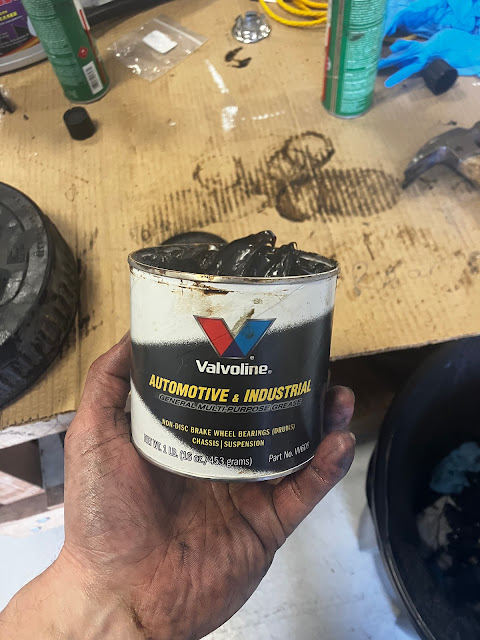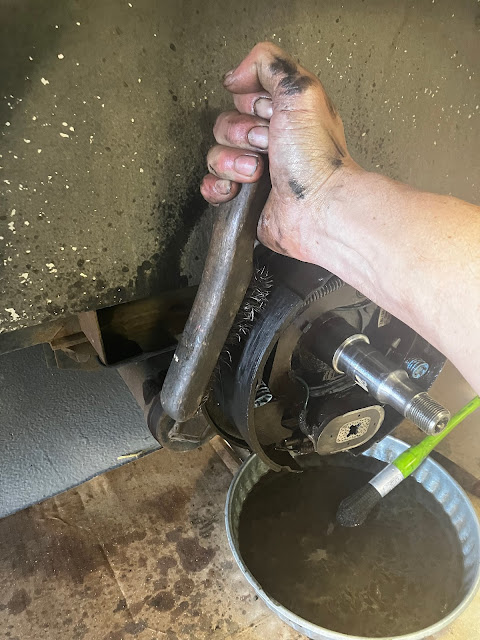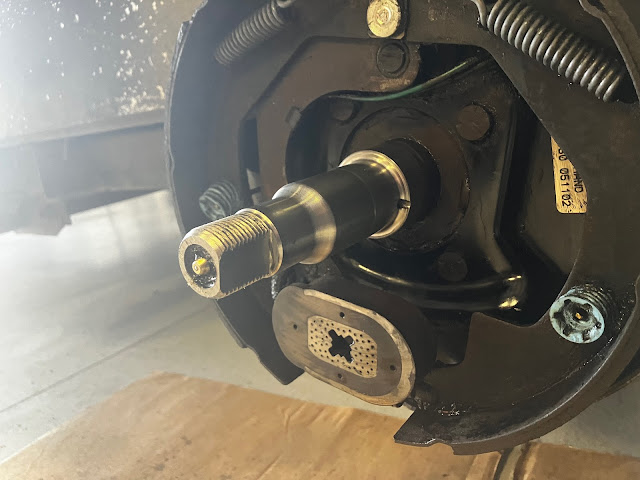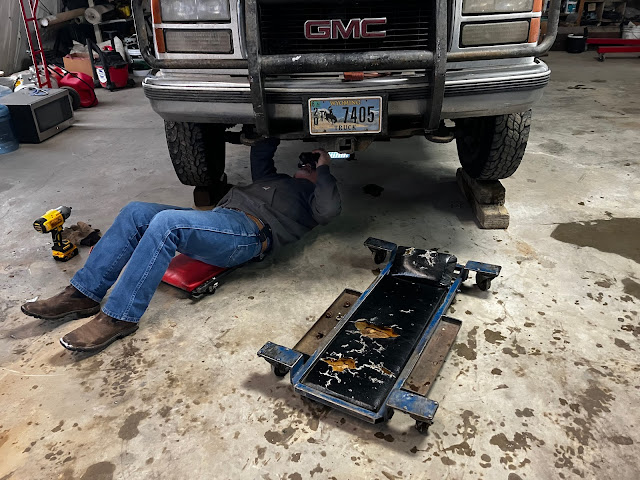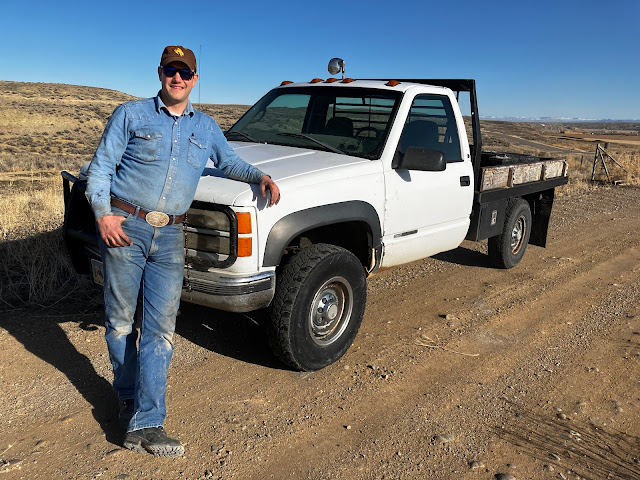My first job out of high school was working at my uncle's trailer sales and service business in Helena Montana. Over the course of that seven year stint, I packed a lot of wheel bearings. It was a dirty job, but I always enjoyed it.
Packing wheel bearings is standard trailer maintenance. Not every year for sure, but maybe every 10k miles or so. A lot of these new trailers have easy-lube hubs, which allows a guy to keep fresh grease on them periodically. That does have drawbacks, in that the hub capacity can only hold so much grease. Once full, out the seal it goes. Dave wanted to get a fresh start on this tandem axle trailer of his.
The first step is to pop the dust cap off. Try your best to not beat on the cap. A chisel right next to the hub works the best.
She's full. There are a lot of different nut keepers these days. Used to be just cotter pins.
This one had a fancy snap rig style keeper. It just pops off.
Once you back the nut off, the outside bearing pops right out.
This is not uncommon with easy-lubes. It's still salvageable, but going to take some tending to.
The grease on the bearings themselves is pretty clean, with no sign of dirt or water. So we are not going to clean them with solvent. Rather, just pack new grease in them.
First step is to pop the old seal out. I find a crowbar works the best.
After you remove the inner bearing, it's good to get rid of all the old grease stored up in the cavity.
A good multipurpose grease serves well for wheel bearings.
Just put a blob in one hand and keep pressing the bearing into it with your other hand, until the old grease starts to purge out of the top side. Then she's packed.
Once packed, it's time to install the new seal. Good seals will have a spring around the inner lip. These should be for sure used on easy-lube hubs.
It's best to pack grease around the inside of the seal on this spring style, so the impact of installing the new seal doesn't cause the spring to jump out. This is also a good opportunity to lube the actual seal surface, where it meets the spindle.
Using a hammer to install the new seal works pretty good, even if it is a claw hammer! Just barely start one point in the hub and tap your way around the rest of it. She'll seat fine.
That hub was pretty greasy. So spraying some brake cleaner on a rag and wiping it down good works well.
Should work.
All that grease is pretty easy to tend to with some solvent or gasoline.
The brake shoes you really want to scrub down if they are greased up.
Again, brake clean works well here too.
Then use a wire brush to really work it out.
Not bad. But grease is deceiving. It can go deep in a brake shoe, and once warmed up can work it's way to the surface and make your wheel skid or not brake well at all. An old farmer trick is to soak the shoes in diesel fuel over night. After removing them, light them on fire, burning out all the old grease. Brake pads are heat resistant, though I would not let them burn too long. Works good in a pinch, though.
Having your hubs torn down is a good time to check the brake magnets. Most utility trailers run electric brakes. When power is sent to them, they magnetize to different degrees, causing the arm to drag, camming the brake lever over, which pushes the shoes against the drum. If a wrench will stick to them when powered up, they're good.
Here you can see how easy-lube hubs work. From the zerk, grease is pushed through the spindle to a back hole, getting grease to the inside bearing without removing the hub. You can see how easy it is to blow out a seal. I recommend no more then 5 pumps from a gun a year. And after 5 years of that, your hub capacity is full and your seal is gonna go. Time to repack them.
Reinstallation is just reverse order. Make sure and rotate your hub as the new seal is going over the spindle surface.
This is about the only technical part. Use a wrench/pliers to set the bearing down hard. Rotate the hub several times back and forth to seat the bearings. Then back it off and move it it until it just makes solid contact. No torquing it down. With the old cotter pin style, you would have to move the nut back or forth to find the nearest hole. In that case you always run a nut looser rather than tighter. A tapered bearing and race will always meet up if loose. Too tight and they'll create friction and go out.
This new clip style allows you to set the nut wherever it is best. Which again, is right at the point of contact after the bearings have been seated.
Push her on and you’re good to go.
Again, don't hammer directly on the dust cap. Tap around the lip until it seats against the hub.
Done.
Most people are capable of packing their own trailer wheel bearings. I find it fun. If you remember anything from this, don't run them too tight. A little maintenance goes a long ways. The last thing you want is to start a grass fire because a bearing went out and you are throwing sparks in the ditch. Besides, you don't want to break down and be late to the dance. You can pack your own trailer wheel bearings. Just be prepared to get dirty.










